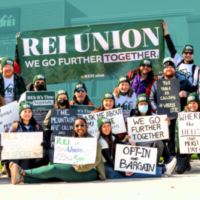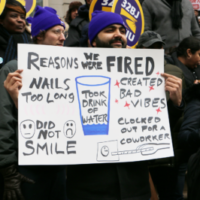Introduction
Amazon is rapidly transforming key aspects of our society and our economy, from the way that we shop to the way that we store and access information to the way that we work. Over the past two-and-a-half decades, the company has built out a mammoth logistics and fulfillment network aimed at moving goods from customers’ computer screens to their front doors faster than ever before. With more than 100 million subscribers to its Prime service, Amazon has made two-day shipping the standard across the eCommerce industry and is working to deliver some products in a day or less as competitors race to catch up.
Amazon has invested billions in artificial intelligence (AI) and robotics to automate its warehousing and distribution network, but it still relies on hundreds of thousands of workers to pull orders, make deliveries, and keep its distribution network running. With more than 200,000 employees in the U.S. and 640,000 around the world, Amazon is the country’s second-largest private-sector employer behind only Walmart.
While workers in Amazon’s fulfillment centers fill essential roles that cannot efficiently be performed by robots, this has not stopped Amazon executives and engineers from treating workers like robots. In the company’s fulfillment centers—massive warehouses stretching over several football fields where customer’s orders are picked and prepared for shipment—workers’ tasks are assigned, and their movements are closely monitored by Amazon’s automated systems.
The system tells workers where to walk and which items to pull. It also monitors each workers’ individual productivity and whether or not they are meeting “rate” by pulling the number of packages that the system thinks workers should be pulling each hour. The system tracks “time off task” or “TOT,” and automatically generates warnings when too much time elapses between scanning packages.[2]
For Amazon workers, rate is a constantly moving goal with new algorithms being introduced to speed up rates and force workers to work faster. In at least one iteration of the rate program, the number of items each worker was expected to pull each hour would be increased as soon as 75 percent of the workforce was able to meet the rate. Under that version of the program the slowest 5 percent of employees would be placed on a training plan and possibly subject to discipline or firing.[3]
Amazon’s constant pressure on workers to move faster has also spread to city streets across the United States. In an effort to reduce delivery costs and improve delivery time, Amazon has established its own network of last-mile delivery drivers. While some of the drivers work for a contractor or other delivery company, all of these last-mile drivers are provided with a GPS device called a “rabbit” that allows Amazon to track deliveries, provide turn-by-turn instructions and monitor drivers’ progress. Amazon sets daily delivery loads for drivers—sometimes as high as 400 deliveries per day during the peak holiday season—and drivers are forced to scramble to keep up with the delivery rate. In interviews about their experience working as Amazon delivery drivers, current and former drivers almost universally reported speeding or violating other traffic laws to keep up with their daily delivery quotas.[4]
Amazon sets the standard for delivery and fulfillment in the eCommerce industry and it also undeniably sets the standards for employment practices and working conditions in the industry. That is alarming news for the millions of workers in the warehousing and logistics industry. Behind the turnstiles of Amazon’s fulfillment centers, delivery stations and other warehouse and delivery operations, tens of thousands of workers are paying for the cost of free two-day shipping with their bodies.
As Amazon’s promise of free and fast delivery has become more and more ubiquitous, so too have reports of unsafe working conditions inside the company’s fulfillment centers. Amazon has topped the National Center for Occupational Safety and Health’s (NCOSH) “Dirty Dozen” list of employers who put workers and communities at risk for two years straight, with NCOSH reporting, “Workers labor at a relentless pace, with constant monitoring of their activities. This high stress environment leads to physical and emotional ailments – but reports indicate that the company does not provide adequate support to those suffering on-the-job injuries.”[5]
Pressure inside some Amazon facilities is so intense that many employees have experienced mental health crises. Analyzing 911 records and police reports, researchers Max Zahn and Sharif Paget found at least 189 instances of emergency services personnel being called to Amazon facilities for suicide attempts, suicidal thoughts, or other mental-health episodes between October 2013 and October 2018. One former employee described their experience at an Amazon facility in Florida in stark terms: “It’s this isolating colony of hell where people having breakdowns is a regular occurrence…[It’s] mentally taxing to do the same task super-fast for 10-hour shifts, four or five days a week.”[6]
And when workers are injured on the job, many have reported that Amazon management forced them back to work too quickly after their injuries or failed to properly compensate them for their injuries. A 2018 investigation by the Guardian uncovered a number of cases where Amazon workers suffering from workplace injuries found themselves homeless, unable to work or without income.[7]
Download the report to read more.
Endnotes
[2] Colin Lecher, “How Amazon Automatically Tracks and Fires Warehouse Workers for ‘Productivity,’” The Verge, April 25, 2019,
[3] Lecher.
[4] Hayley Peterson, “Missing Wages, Grueling Shifts, and Bottles of Urine: The Disturbing Accounts of Amazon Delivery Drivers May Reveal the True Human Cost of ‘free’ Shipping,” Business Insider, accessed August 15, 2019,
[5] National Council for Occupational Safety and Health, “The Dirty Dozen,” 2019,
[6] Sharif Paget and Max Zahn, “‘Colony of Hell’: 911 Calls from Inside Amazon Warehouses,” The Daily Beast, March 11, 2019, sec. tech,
[7] Michael Sainato, “Accidents at Amazon: Workers Left to Suffer after Warehouse Injuries,” The Guardian, July 30, 2018, sec. Technology,




